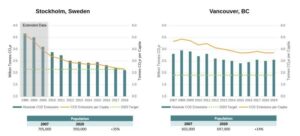Stockholm met its 2020 greenhouse gas emission goals 2 years early and is well-positioned for 2030 and beyond, despite a large increase in population and a large stock of old buildings. Which policies and actions have put Stockholm at the forefront?
Smart City Sweden together with Reshape Infrastructure Strategies organised a panel discussion on the climate city pledges, with emphasis on strategies to decarbonize the heating & cooling sector. We discussed the ambitious targets and policies that direct city infrastructure in the heating and cooling sector, with a focus on the US, Canada, and Sweden.
Over 55% of the global population lives in cities. Cities account for over 65% of the world’s energy consumption and 70% of GHG emissions are in urban areas. And most population growth in the next 30 will be in cities. Cities are key actors in mitigating and adapting to climate change. Hundreds of cities have already declared climate emergencies, and many have also established targets to be carbon neutral, fossil-free, energy independent, and/or fully renewable by 2050 or before. But these ambitious targets are meaningless without interim targets and real policies to direct city infrastructure towards these goals. Energy use for heating and cooling accounts for a large share of the carbon footprint of cities.
The image below shows the comparison of Vancouver and Stockholm. Stockholm now has roughly half the per capita emissions of Vancouver (which in turn has among the lowest per capita emissions in North America). The carbon intensity of electricity is low (< 25 kg/MWh) in both cities. So the biggest difference? Stockholm has extensive heat networks that it has decarbonized through a mix of bioenergy (including a new pilot for biomass energy carbon capture storage), waste heat recovery (including an initiative to expand waste heat recovery from data centres to 10% of all heating supply) and large-scale heat pumps.

CO2 emissions in Stockholm (left) and Vancouver (right). Credits: Connor Reed, Reshape Infrastructure Strategies
Watch the recorded discussion below to further explore successes, ongoing challenges and future prospects for reducing GHG emissions in cities.